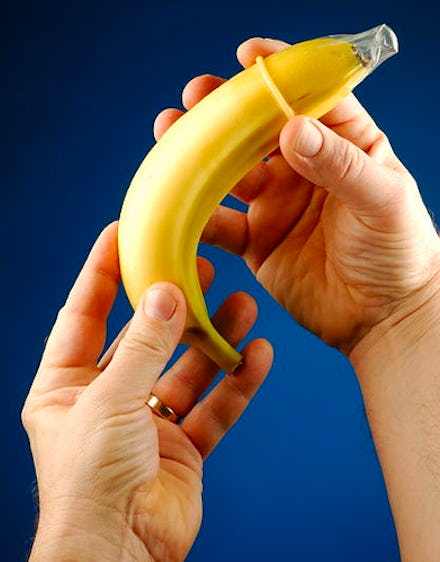Could You Pass a Middle School Sex Ed Test? Take the Quiz

By now, you are (hopefully) intimately familiar with your private parts. But how much do you really know about them? Better yet, how much do you know about the opposite sex's reproductive system? You might be surprised to discover how you'd stack up against an average student taking a sex ed class.
Test your reproductive knowledge below with this smattering of reproductive fun facts. According to a March 2012 report from the National Conference of State Legislators, fewer than half of U.S. states require sex education in schools, so if you find yourself struggling, don't be alarmed — you're probably in pretty good company. While teen pregnancies have fallen to record lows in America, 1 in 4 U.S.teens are still being taught the abstinence-only approach to sex ed, glossing over some of the more tricky areas, like the difference between a testicle and a scrotum.
So take the quiz and see how much you really know about your own reproductive system, and that of your partner. Go head-to-head, or just go it alone — either way, hopefully you'll learn something.
Hint: Mark your answers separately and check them below.
1. Menarche is a type of butterfly. TRUE OR FALSE?
2. Females are born with a lifetime supply of eggs. TRUE OR FALSE?
3. Only guys have nocturnal emissions (or, wet dreams to the lay person). TRUE OR FALSE?
4. Ejaculated sperm can live in a woman's body for up to five days. TRUE OR FALSE?
5. A penis has more nerve endings than a vagina. TRUE OR FALSE?
6. The clitoris is the only human organ that exists for pleasure. TRUE OR FALSE?
7. Women can ejaculate, too. TRUE OR FALSE?
8. You need to have regular erections to keep your penis from shrinking. TRUE OR FALSE?
9. You can fracture a penis. TRUE OR FALSE?
10. Sperm is the same thing as semen. TRUE OR FALSE?
1. Menarche is a type of butterfly.
FALSE.
You're thinking of the majestic monarch butterfly. Menarche is a girl's first period, which most girls can expect to arrive around age 12.
2. Females are born with a lifetime supply of eggs.
TRUE.
At birth, girls are born with all the eggs they will ever have: approximately 1 million. However, by the time puberty hits, a girl's ovaries will house roughly one-third of those original eggs. Over the course of her reproductive lifetime, a woman will release — or ovulate — 300 to 400 eggs.
3. Only guys have nocturnal emissions (also known as wet dreams).
FALSE.
While popular narrative focuses on the male "wet dream" experience, women have them too — it's just harder (pun intended) to find evidence of women orgasming in their sleep. Back in the day, Alfred Kinsey reported that by age 45, 37% of the nearly 6,000 females in his research sample had experienced nocturnal emissions. More recently, in a 1986 study of university students, 37% of female respondents reported experiencing a 'gasm while snoozing.
4. Ejaculated sperm can live in a woman’s body for up to five days.
TRUE.
According to the Mayo Clinic, sperm ejaculated into a vagina can live in a woman's cervical mucus or upper genital tract for three to five days.
5. A penis has more nerve endings than a vagina.
FALSE.
A clitoris has 8,000 nerve endings, compared to the penis' 4,000. Better yet, clitoral stimulation can affect up to 15,000 other nerve endings in a woman's pelvic area. Wowza.
6. The clitoris is the only human organ that exists for pleasure.
TRUE.
Consider it a karmic exchange for monthly periods. The clitoris' sole purpose in life is providing sexual pleasure. While the penis likewise provides pleasure, it also serves reproductive and urinary purposes.
7. Women can ejaculate, too.
TRUE.
According to the National Institutes of Health, female ejaculation has been on the records for some 2,000 years. However, female ejaculation is not what pornography belies it to be; the "squirting" phenomenon is actually the expulsion of diluted fluid from the urinary bladder, whereas true female ejaculation is the release of a thick, whitish fluid, biochemically similar to men's ejaculate.
8. You need to have regular erections to keep your penis from shrinking.
TRUE.
The penis follows a "use it or lose it" mantra. Without regular erections, a penis loses smooth muscle tone and elasticity, and can shrink 1-2 centimeters. Better get to "exercising," fellas.
9. You can fracture a penis.
TRUE.
Beware of overly rigorous sex or masturbation. While there is no bone in a penis, it is possible to cause serious damage — or penile fracture — to an erect penis. As the folks at the Mayo Clinic explain, if an engorged penis is suddenly or forcefully bent, the corpous cavernosum (the two cylinders in the penis responsible for erections) may rupture. Ouch.
10. Sperm is the same thing as semen.
FALSE.
Remember the grade school lesson that all squares are rectangles, but not all rectangles are squares? The same logic applies here. Semen, or seminal fluid, contains sperm (in fertile males) but that's not all. During the process of ejaculation, other liquids from the prostate gland and seminal vesicles are added to the mix. So all sperm is semen, but not all semen is sperm.